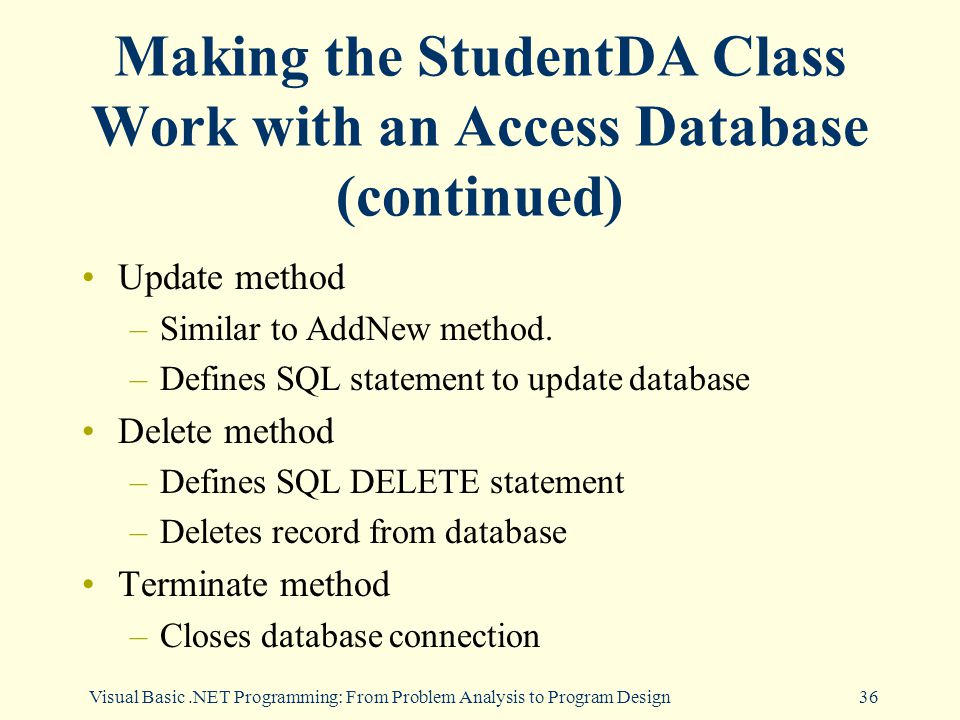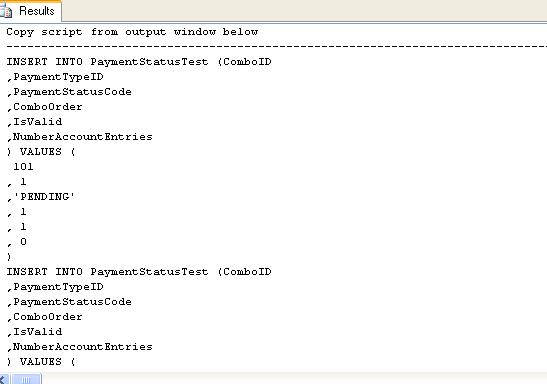Sql Update Command In Vb6 Source

Code. SMART for VB6 - The Complete VB6 Toolset. Keen to see Code. SMART 2. 01. 3 for VB6 in action? Well, you have reached the right place.
We have prepared for you a few sections. Code. SMART 2. 01. VB6 key features. Brief highlights. All the features it adds to Visual Basic are accessible through the main menu and four toolbars it registers with the environment. Code. SMART tools are hosted or display their results within dedicated tool windows that can be moved or docked. Code view enhancements are displayed directly in the Visual Basic standard code editor window.
The Microsoft OLE DB Provider for SQL Server, SQLOLEDB, allows ADO to access Microsoft SQL Server. Connection String Parameters. To connect to this provider, set the. The ADO Open Method: recordset.Open Source, ActiveConnection, CursorType, LockType, Options : Parameter Description; Source: This is the source of the recordset. INTO, USING, ON. INTO and USING define the destination and the source of the MERGE data. Code displaying this section of the statement appears below.

Microsoft Access products, addins, developer tools, consulting services for Visual Studio.NET, LightSwitch, SQL Server Azure in Vienna, Virginia Washington DC. ADO.NET SQL Server Connection You can connect your VB.Net application to data in a SQL Server database using the Microsoft.NET Framework Data Provider for SQL Server.
Tabs are added to the Immediate window, which is thus converted into a central reporting place while it does not loose its initial functionality. Full screen support: yes, it's true, you can code in VB6 while completely maximizing the work area! Tabbed MDI IDE: Code. SMART can change the Visual Basic standard multiple document interface (MDI) into a modern Tabbed MDI one similar to VS.
NET and other modern environments. Inject beauty into built- in VB6 core subsystems like the Object Browser and the Intellisense - the old, 1. Code. SMART's. main subsystems. With the Code. SMART Code View Assistant. Visual Basic code window dramatically changes with critical information provided on many control statements, branch lines to visually identify code nesting and assisted. Well. not just that - it supports filtering, searching, navigation history, item highlighting, logical view etc. Components can be further expanded to show their procedures.
Delete Query Tutorial. The Delete query in MS Access SQL command used to remove one or more rows of data from a relational database table. The number of rows deleted. UPDATE is a DML statement that modifies rows in a table. Single-table syntax: UPDATE Here, we will see how to create select, insert, update, delete statements using stored procedure.
Logical: where components can be logically grouped in user defined folders to ease the application's functional scheme comprehension. Code expansion is also available. Persistent between sessions on a per- project basis. The node search pane: used to search for nodes in the Code. SMART Project Explorer. The workbench pane: this one can help you focus on certain elements by defining shortcuts to them. Persistent between sessions on a per- project basis.
By using the. 'Code Flow - Options' dialog, you can configure which code constructs you are interested in seeing in the tree. You will be able see all the controls hosted on the current designer, including containment. Controls can be sorted alphabetically or by following their tab order. Additionally, designer components are displayed in a Project Explorer- like. SCC etc). It can be seen as a Visual Basic repository in.
It can be seen as a control quality tool for Visual Basic programmers who want to refine the code they write by making it smaller, faster and less. The Code Analyzer covers three major problem categories.
Dead (unused) code and symbols: code that is no longer used. This code usually has a negative impact on the compiled program size, not to speak about having a significant.
Performance issues: certain statements and code that is usually considered a bad choice from an execution speed perspective. Potential problems: code that has a known potential for generating errors. It can be seen as both a user interface quality control tool and a user interface standard enforcement tool with. The Designer Analyzer covers three major problem areas.
Designer issues: refers to most common designer- related (form, user control, user document, property page etc) issues. Control issues: refers to control- related problems. Other (general) issues: refers to problems that could not be included in the above two but still apply to the application user interface. What can be more embarrassing than delivering an application and realizing you have spelling errors in its. Let's face it, we all felt bad because of this at least. We did it too - so we decided it's the time to have a Spelling Checker component in Code. SMART. Here it is what this tool can analyze for you.
Caption and the Text properties. There are even more analyzer tools shipped with Code. SMART. The Strings Reviewer: this tool does somehow share part of its goals with the spelling checker. Its purpose is to help you produce a correct user interface as for the text it. Strings Review was designed to ease the phase of logical word combination (phrasing). The Code Commenting Conformity Checker: many organizations employ code documentation standards - and it is recommended even for single developers to adhere to such one. Enforcing a code documentation standard can be.
In such cases, an auto- text feature like the one found in many professional text editors could save you a lot of time and allow you to concentrate on the program. Code. SMART Auto. Text system! Also, a very useful feature is the one that switches an assignment operator's parts - especially when writing database applications and having to initialize.
Moreover, Code. SMART can help to quickly format regular or SQL strings. These buffers can be filled with any piece of Visual Basic code and. Visual Basic code window by using a simple shortcut key system. Code. SMART has a Tab. Order Designer which can help you automate this process. You can either set the order manually by simply sorting a list, or you can even let the tool automatically establish.
The tool provides a hotkey generation mechanism along. The Code. SMART Change Name and Text Properties tool can ease manual property setting and automate property- to- property value generation. Code. SMART can do for. UI Standard. Properties Manager settings. By using the Code. SMART Code Formatter you can.
Reshape (indent) your code. Manage the amount of blank lines used to emphasize certain code elements. You can instruct Code. SMART to insert a specified amount of blank lines before and/or after specific. Visual Basic keywords and also to limit the amount of total consecutive blank lines.
Also, already split code lines can be compacted. Code. SMART offers you the possibility to arrange code elements based on their scope. Comments are based on templates and you can use the Comment Templates.
Manager in order to customize them. Can be added to the current component/procedure only or in bulk. Managed Antivirus Active Protection In Error Or Err.
Embrace- type comments (block comments) used to enclose a block of code between descriptive notes. Inline comments: other comments (usually single- line, but not necessarily so). When it comes down to protecting your code and pinpointing problem causes, Code. SMART can help with some very powerful subsystems. The Code. SMART Error Handling Engine: Welcome to the most powerful VB6 error handling system ever! It is based on the concept of error handling scheme i. This template completely describes the error handling.
Schemes can be assigned to different types of Visual Basic components (Classes, Forms, Modules etc.) or to procedures (members) that match a certain pattern. This is achieved by adding a dedicated module to your. Ax. Visual. Logger) where the information can be logged (of course, you can use your custom logger if you want!). This way your program can communicate unexpected events to a. Also, handling exceptions ensure that a termination code containing clean- up tasks is executed even if an exception. There are three task types managed by Code.
SMART. Assigned tasks: tasks that are assigned to different members of a team, with start and due dates, code links, developer assignments. Personal tasks: similar to the assigned tasks, with the only difference that they are visible only to their creator and have no developer assignments.
Comment (TODO) tasks: can be used as bookmarks in code, or as reminders etc. A non- comprehensive list includes. Auto. Save and Auto. Backup: pretty obvious what it does, and it works at specific time intervals. Well, not anymore since Code. SMART adds that for you!